
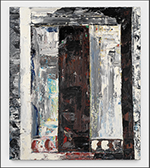
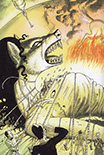
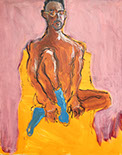
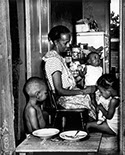
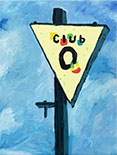

They Exists in the Multiverse:
A Review of {\}() {\}∆‡!(){\} (No Nation) at Comfort Station, Chicago, August 18, 2023
by John Thomure
In Chicago, there exists a portal to another dimension: {\}() {\}∆‡!(){\} (No Nation) Tangential Unspace Art Lab. As their name implies, it is not merely
a physical place. It is a state of mind, an experience of the body. When you go to {\}() {\}∆‡!(){\}, there is no way of predicting what you might see. {\}()
{\}∆‡!(){\} grew out of Happy Dog–a second floor go-to for parties and D.I.Y. concerts. When Amaya Torres took over in 2010, and claimed their moniker, they established a long running experimental art space. {\}() {\}∆‡!(){\} host innumerable shows nearly every weekend as well as a three to six month residency program which houses international artists, burgeoning art students, and long-lost travelers alike. It is a home for the dispossessed, the strange, and the otherworldly.
As part of Comfort Station’s “Force & Motion” series, {\}() {\}∆‡!(){\} was invited to present a series of performances. The Logan Square institution states that “Force & Motion” allows local groups to take over their space to showcase new ideas and approaches to creating community. This edition began with Amaya Torres. In between growls and piercing buckshots of distortion, Torres initiated an incantation to manifest anything we could imagine. We passed around a blank piece of paper, filling it with our thoughts. Concurrently, Amaya prepared the other ritual elements like folding paper airplanes. After collecting all of these ideas, possibilities, and impossibilities Amaya enrobed themselves with the paper airplanes. They then lit the airplanes on fire and bolted flailing and howling into the night. Torres’ performance was somewhere between ritual magic, great black metal, and avant-garde pantomime. Their medium is reality itself—that moment when the performance is taking place. The actions we all performed together pushed against the rigidity of real life.
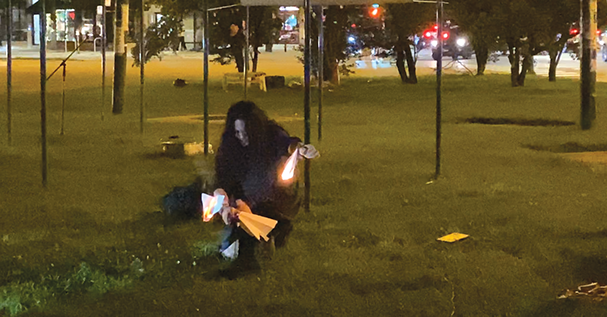
Amaya Torres lighting paper airplanes on fire. Photo by John Thomure.
Following Torres was Aza Greenlee, {\}() {\}∆‡!(){\}’s co-manager and impresario. Their performance was much more subtle than Torres. They paraded out with a menagerie of bags, food, and two plastic swords amongst many other things. They began frantically maneuvering everything around, picking up an object while dropping another, tossing another object aside while bending down to grab even more. Greenlee cycled through their assortment of materials at a frantic, yet consistent pace. Swords almost made it into their scabbards, boxes nearly stayed standing, and at one point Greenlee flicked a lit blowtorch around with the grace of a butterfly knife. The resulting effect was one of subtle immersion and rising tension with no final climax.
After a brief intermission, Holden McClain performed. What played out was the tragedy of an American party girl. A party girl seeking an ever-elusive sense of affirmation and love in a wasteland of loneliness and desperation. The performance oscillated between striptease and vaudeville. The noir staging, along with the punk Pagliacci clown makeup, evoked the vaudevillian combination of sexual titillation and tragicomedy perfectly. The whole affair was a feast for the senses as the sickeningly sweet smell of store-bought frosting permeated the nostrils.
It was after Holden’s performance that Amaya passed me a camera and asked if I could help document. This is par for the course at {\}() {\}∆‡!(){\} shows, even the documentation has an air of improvisation and self-autonomy. Aranza Cortés Karam’s Digital Disobedience Lab embodied these same concerns, but for our personal technology. Karam’s piece was part workshop and performance. We were walked through the basics of cyber security, especially regarding the location tracking capacity of all of our apps. Too often, we agree to giving away our digital information and the Digital Disobedience Lab exemplified this.
The final performance of the night was Érika Ordosgoitti. It began with Érika emerging from another room dressed in nothing but a mask of meat. Honestly it could have been made of anything. Érika demanded to see our real faces—the faces we hide when we are at work, at a bar, at home with our family. The demands got more and more heated. “Show me your real face!” Érika started shouting at us and we all began complying. Érika shouted at us and we shouted back at Érika. The confrontational style is common to Ordosgoitti’s performances which seem hellbent on breaking from normal routines. Our collective screaming self-expression built to a frenzy. It felt like someone was moments away from losing all pretense and smashing a window or spastically dancing. Just as quickly as it had started it was over, but that fever pitched feeling remained deep in our guts. Leaving Comfort Station, I felt like a tightly wound coil ready to let loose.
{\}() {\}∆‡!(){\} maintains a special place in my heart. It was the first place where I saw live performance art. They repeatedly host international film festivals, visiting artists, and allow emerging artists and curators the opportunity to gain practical experience. It stands as a high watermark of Chicago art. However, despite all of this, {\}() {\}∆‡!(){\}’s future is not guaranteed. The owner of their building, Ken Lubinski, has expressed his desire to sell the building at some point in the near future. This is compounded by Equity Arts, a non-for-profit arts organization, which is attempting to buy the building from Lubinski. Despite the claim to “equity,” this non-for-profit has expressly stated that {\}() {\}∆‡!(){\}, alongside fellow venue Tritriangle, will be evicted if this comes to pass.
{\}() {\}∆‡!(){\}’s plight expresses the contradictions at the heart of being an artist in the United States: the desire to create open spaces where people are allowed to express themselves freely and the increasing difficulty of finding and maintaining actual physical art spaces.
John Thomure is a performance artist and writer currently based in Chicago. His performance and writing practices fixate on local Chicago art history and exploring forgotten or overlooked artists and their archives.
Footnotes
1. Amaya Torres in discussion with the author, August 31, 2023.
2. “Force and Motion.” Comfort Station. Accessed September 15, 2023. https://comfortstationlogansquare.org/force-and-motion.
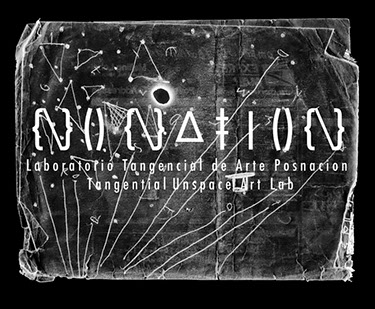
{\}() {\}∆‡!(){\} (No Nation) Logo.
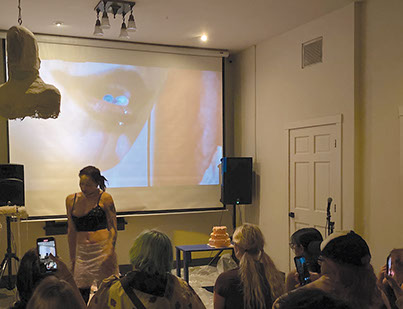
Holden McClain performing. Photo by John Thomure.
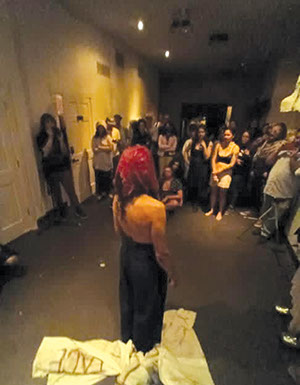
Érika Ordosgoitti performing. Photo by Sarah Pramuk.